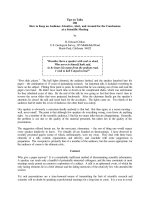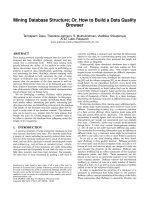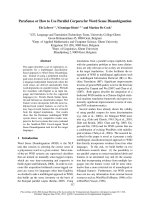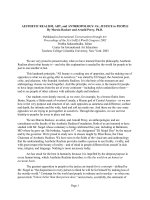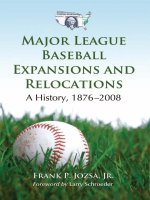minor league baseball boom or bust to communities
Bạn đang xem bản rút gọn của tài liệu. Xem và tải ngay bản đầy đủ của tài liệu tại đây (43.88 KB, 6 trang )
Minor League Baseball: Boom or Bust to Communities? Despite the
occasional disappointment, minor league baseball provides
manycommunities with economic development and an improved quality
of life. Communities assmall as Elizabethtown, Tennessee or as large as
Phoenix, Arizona have shared thecommon bond of being the homes of
major league farm teams. This is referred to as theNational Association
of Professional Baseball, or more commonly known as the
"minorleagues." As the popularity of major league baseball seems to be
decreasing due to therecent player strike, free agency, and anti-trust
labor laws, minor league baseball hasgenerated excitement that can only
be associated with baseball in the good old days. Thisexcitement is a
purity of spirit which the majors no longer possess. "It is baseball in
itssimplest form just ball, bats, gloves, and lifelong dreams. The parks
are generally small,the players, hardworking young men whom local fans
are likely to run into the next day atthe mall or maybe the corner bar. A
family of four can see a game, eat dinner maybeeven pick up a souvenir
or two without having to consider a second mortgage. Nolockouts, no
holdouts, no five-dollar beers, and the umpire is the only one who can call
astrike. "Just the national pastime, played the game it is," says one editor
of The MinorLeague Baseball Book. There are currently 156 teams
that are part of the National Association ofProfessional Baseball. This
number will grow in the next few years with the addition oftwo expansion
teams at the major league level. There have also been a number
ofindependent leagues formed which are said to be the "future of minor
league baseball." The success of these teams have shown how the value
of these franchises have grown over the past ten years. In the past, class
AAA teams would sell for three hundred thousanddollars while a smaller
class A team went for fifty thousand. Today the class AAA teamsare
being sold for as high as five million dollars while class A teams are going
for aroundone million. The best example of the fact that franchises have
grown in value over theyears is the Reading Phillies. Joe Buzas, a minor
league baseball entrepreneur, has ownedand operated twelve minor
league teams in seventeen cities since 1956. In 1976, Buzasbought the
Reading Phillies franchise for $1. Ten years later in 1986 he sold it
for$1,000,000. The addition of minor league baseball to
communities can provide many benefits. The greatest benefit is the
overall economic lift that minor league baseball brings to acommunity.
Minor league baseball provides additional jobs. Initially, local
individualsbuild the stadium. This project takes from six months to a
year. An average of 15 full-time and 125 part-time individuals ranging in
age from high school students to older,retirees are employed at the
stadium. The stadium will be beneficial if it's useful for the baseball
fan as well as anyresident. For approximately seventy nights a year, a
stadium will provide an opportunityfor the baseball fan to view
professional baseball up close, to identify future stars and tofollow their
careers, and to get a glimpse of current major league players who
occasionally are assigned to a minor league team for rehabilitation
purposes or who are inthe last stages of their career. The stadium,
however, should be more than that. It should be a community facility that
provides many types of recreational resources. A newstadium is capital
improvement and should have a life of more than two decades. If
thestadium and team are to be evaluated as a true community resource,
they must serve theentire community. If a stadium is utilized during the
winter months, when baseball is notplayed, not only will a community's
quality of life be enhanced, but the economicdevelopment function of the
stadium will be maximized as well. The addition of minor
league baseball to an area can be an important tool inrevitalizing an area.
The best example that comes to mind is the Harrisburg Senatorslocated
in Harrisburg, Pennsylvania. In 1980, after three decades of decline,
Harrisburgwas one of the most distressed cities in the nation. It had lost
its credit rating and facedbankruptcy. By 1988, under the leadership of
Mayor Stephen Reed, Harrisburg hadbecome the leading city in
economic growth among those with a population 50,000-75,000. The
turn around of the city gained recognition when Harrisburg was named
thesecond best investment city in eastern United States. Harrisburg
officials have identifiedseveral benefits that the city has derived from the
presence of the Harrisburg Senators. The most important benefit has
been the redevelopment of City Island. City Island wasReed's
announced site for a future stadium. The mayor anticipated using the
stadium asthe centerpiece for the redevelopment of City Island. The
mayor viewed the stadium asthe anchor for an economic development
project that would be highly visible and wouldhelp attract large crowds of
people to the island. This would lead in making other eventson the island
more feasible. Reeds dream became a reality in1986, when they
beganconstruction of Riverside Stadium on City Island. In March 1987,
the Pittsburgh Piratesclass AA team began play in Harrisburg.
Harrisburg's inaugural season was nothing shortof spectacular as the
Senators won the Eastern League championship and attracted223,000
fans their first year. Their success continued throughout the 80's and into
the 90'swith attendance of 216,940 in 1988; 200,196 in 1989; 223,533 in
1990; and 233,423 in1991. Their attendance in 1988 and 1990 was the
highest in the Eastern League. Thesuccess of the Senator's made the
revitalization of City Island possible. The city hasconstructed another
sports field, where a minor league football team and communitysoccer
team play. Concerts also are held on this second field. Riverside Village
providesa number of food stands that attract downtown workers and
residents and city visitors tothe island. A marina and a riverboat, which
presents an hour-long cruise, have been established off the island. City
officials estimate more than 600,000people visit the island annually. The
most activity, however, takes place from April toDecember. The
Harrisburg Senators remain the principal attraction, but other features
andactivities on the island are becoming established in their own right.
Minor league baseball also brings tourists and visitors to the
community. In addition to the game itself, many travelers will visit local
attractions as well as stay innearby hotels. The visiting teams brings a
strong following with them to many roadgames. These are tourists that
would not be visiting the area if minor league baseball didnot exist.
These baseball fans would not be supporting local restaurants, stores,
gasstations, if minor league baseball did not exist. Although minor
league baseball has been a dream come true for cities likeHarrisburg, it
has been a nightmare for other communities. In Hudson Valley, New
York,the community found its case of baseball fever has turned into a
"financial jam and it maynot find the way out for a long time." Hudson
Valley was a community that was stillsuffering from a 8,000 job losses
from a recent IBM downsizing effort. The prospect ofluring a minor
league baseball team sounded like a good way to boost the local
economy. A nonprofit organization was formed, and a plan was
immediately developed to build thestadium. The cost for the stadium
would be 3.75 million paid by the county, and anadditional 1.75 million
would be financed by the private sector. "It was supposed to bethe
world's greatest public-private partnership, now, everybody wants the
county to pulltheir chestnuts out of the fire," Dutchess County legislator
Woody Klose said. Althoughthe team has been a rousing success and
routinely sells out the 4,000 seat stadium, thegroup constantly finds
themselves in financial debt. Many people in the area blame it ontime.
The time factor was the biggest limitation. The big push to get the the
stadium built as quickly as possible forced an overrun of nearly two
million dollars. "In the time mostpeople built a house, we built a stadium,"
said David Avenius, an assistant to the DutchessCounty Executive.
Klose said that it is extremely important to get the stadium financingup
front. He still has a recommendation for other communities that want to
lure a minorleague baseball team. "Go into therapy," Klose said. "Deep,
deep therapy"(Slavin B1). Some communities that have had
financial success, have suffered the lossof their team because of
franchises relocating. Corporations abandon communities wherethey
have been located for many years, leaving those communities and their
residents witha weakened economy and social structure and without any
compensation or resources toassist recovery. Unfortunately, relocation
has played a part in minor league communitiesleaving cities with an
abandoned stadium. Local officials often cannot respond positivelyto an
team owner's demands because of the limited resources available in
smallercommunities. This demonstrates the importance of stadiums in
city-team negotiations,and they show how the business interests of team
owners and local officials often conflict. Location decisions of owners
tend to be business decisions that are designed tomaximize their financial
interests. Joe Buzas, owner of the former Fresno Suns, chose notto
remain in Fresno because of competition from the university for the fans
and advertisingdollars. The Fresno Suns had been playing in a run down
stadium that received minimumfinancial support form the city. Fresno
State University agreed to let the Fresno Suns playat their modern facility.
However, the university wanted half of the ticket revenue and allof the
concession revenue the Suns would receive. In 1988, after receiving
permissionfrom the California League, Buzas moved the franchise to
Salinas, California. To this daythere is no professional baseball being
played in Fresno, California(Johnson 133). Franchises Relocating
have also been based on a community not meeting the needsor the
demands of the owner. Charlotte Knights owner George Shinn wanted to
build a stadium that would be capable of hosting more than a minor
league baseball team. Tomake his stadium plans work, Shinn had to
avoid use restrictions of this stadium andconsequently needed more land
than he could obtain in Charlotte. Shinn and Charlotteofficials
negotiations eventually failed because both parties had conflicting side
issues andagendas. City staff members struggled to control the stadium
issue. They were primarilyconcerned about protecting the city's
investment in the new coliseum. Shinn, lookingbeyond Class AA
baseball, dreamed of a stadium that could potentially accommodatemajor
league baseball, professional football, and other forms of entertainment.
Later, heviewed the project as a revenue-generating real estate deal. He
was not interested in astripped-down stadium(Johnson 121). An
important benefit that has been seen first hand by individuals is thequality
of life minor league baseball adds for the community. It provides
affordable familyentertainment by charging fans low ticket costs. In
Ottawa, Canada, the ticket pricesrange from just $4.20 to $8.40 the
least expensive seats cost less than one-fifth of theequivalent for Ottawa
Senators hockey games. "This is affordable family entertainment. You
can't make the excuse you can't afford to come and bring the kids too,"
says OttawaLynx owner Howard Darwin(Allen 48). In Frederick,
Maryland, and in Hagerstown,Maryland, any child who comes to the ball
game in any sports uniform gets infree(Morgenson 40). In Scranton
Wilkes-Barre, Pennsylvania, home of the Class AAARed Barrons, ticket
costs are $3.50 for bleachers, $4.50 for upper grandstand and $6.50for
lower box seats. While in Philadelphia, Pennsylvania, home of the Major
LeaguePhillies, tickets range from $5 for bleacher seats at to $16 for level
seats behind the boxseats. The contrast in ticket prices between the
minor leagues and the major leagues havebeen seen all over the United
States and Canada. Minor league baseball has also done a
tremendous job of providing good qualitybaseball as well as providing
entertainment at the game. This has been done with a wide range of
promotions. In some stadiums around the United States and Canada,
promotionshave been the major reasons for fans attending the game. In
Prince William, Virginia,home of the Class A Cannons, general manager
Kenneth Shepard has come up with a valetcar wash and a preferred
parking pass for season ticketholders. For $2, you can have yourcar
washed while you're watching the game; and for $75 a year, fans can
have their ownassigned parking spot(Morgenson 9). Robert Rich, Jr.,
president of Rich Products Corp.in Buffalo, the nation's largest family
owned frozen food manufacturer, has owned theBuffalo Bisons since
1983 and was among the first to make his games "events." He putson a
weekly fireworks display, sponsors at least three major concerts a season
last yearthe Beach Boys, Aretha Franklin, and Huey Lewis and the
News came to town anddreams up contests where fans participate on
the ball field. Rich explains, "Thursdays arePizza Hut Pop-up Night.
Before the game, contestants come out onto the field and try tocatch
three pop-up fly balls. If someone catches all three, everybody in the
stadium gets afree pizza from Pizza Hut"(Morgenson 9). In Wilmington,
Delaware, promotions includethe Dizzy Bat Race, Dirtiest Car of the
Game, Frisbee Toss, and minor league baseball'sversion of "Let's Make a
Deal." There is no limit to the creativity that they have come upfor
promotions at minor league baseball games Another aspect that has
played a part in adding to the quality of life has been theattitude of the
fans. Unlike the fans at the major league games who seem to keep
tothemselves and have intolerable attitudes, fans are unusually friendly at
minor leaguegames. Leanne Pagliai is Vice-president of the High Desert
Mavericks, a Class A SanDiego Padres farm team in Adelanto, California.
Pagliai has a theory: "Our commutersociety is so splintered today,
citizen's can't bond as much as a community anymore;minor league
baseball is a chance to get together with your neighbors." Darwin
explains,"Away from the world of world-class, people behave normally.
They are decent andfriendly. They have time to chat. The fans are not
impatient with the ball players. The ball players, paid salaries that are
smaller than those of many fans, are approachable andnice. They give
balls to kids." Darwin also credits his success in Ottawa because he
wasable to spot a desire by the fans to be part of something
small(Gordon 9). In Durham, North Carolina, minor league baseball
has had an impact on thecommunity both positively and negatively. They
were an established franchise that beganto head in the wrong way.
Durham, like many communities that have face "hard times,"learned from
their mistakes and bounced back to become the most nationally known
minorleague team. Durham is located in North Carolina and is part of the
"research triangle"along with Raleigh and Chapel Hill. In the 1980's,
Durham's economic image began tostruggle. In the mid 1980's, the North
Carolina Symphony moved its home from Durhamto Raleigh. This was
believed to be caused by Durham's lack of respect in the Carolinaregion
and harmful intercity competition. Another problem was the prohibition by
thestate legislature against Durham annexing Research Triangle Park.
This was also due tothe declining city image. Durham in the 20th
century had a rich tradition of minor league baseball. Durhamhoused the
headquarters of the National Association of Professional Baseball
Leaguesfrom 1933 to 1947. The Bulls were one of the most successful
teams in the minor leaguesin the 40's, 50's, and most of the 60's.
However, towards the end of the 60's, Durhambegan to experience some
"hard times." This was due to poor management and thedecadence of
Durham Athletic Park (DAP). In 1971, Durham began its final season as
thehome of the Durham Bulls. In 1980, Miles Wolff brought minor
league baseball back to Durham. Wolff spent$2500 for the rights to the
team and $25000 to restore Durham Athletic Park. In 1988,the Durham
Bulls and minor league baseball got national attention with the success of
themovie "Bull Durham." A year before "Bull Durham", Raleigh officials
tried to lure theBulls from Durham in hopes that a higher-level team would
be brought to the Raleigh-Durham area. This attempt failed and baseball
in Durham remains to this day. The Bulls were one thing that intercity
rivals Raleigh and Chapel Hill did not have. Thiswas recognized as
substantial to the city of Durham's image. Durham to this day is themost
recognized minor league baseball team. It has led the Carolina League
attendancefor the past five years and has built a new stadium where the
Bulls began playing last year. Their old stadium remains a historical minor
league baseball landmark where high schooland local college baseball
games are played. The Bulls are also the leading memorabiliaseller in
the entire minor leagues. Not every community will achieve the success
of Durham, North Carolina, becausethere is no 100% guarantee in minor
league baseball. However, the majority of towns andcities throughout the
United States and Canada hosting minor league baseball teams
haveexperienced many benefits. Economic growth and development,
community identity andpride , affordable family entertainment, and an
improved the quality of life indicate thatminor league baseball is here to
stay.



